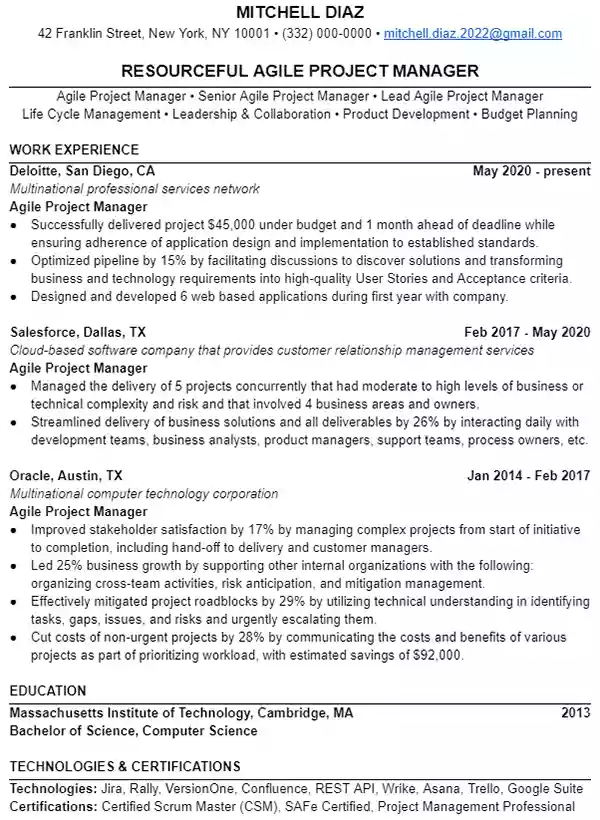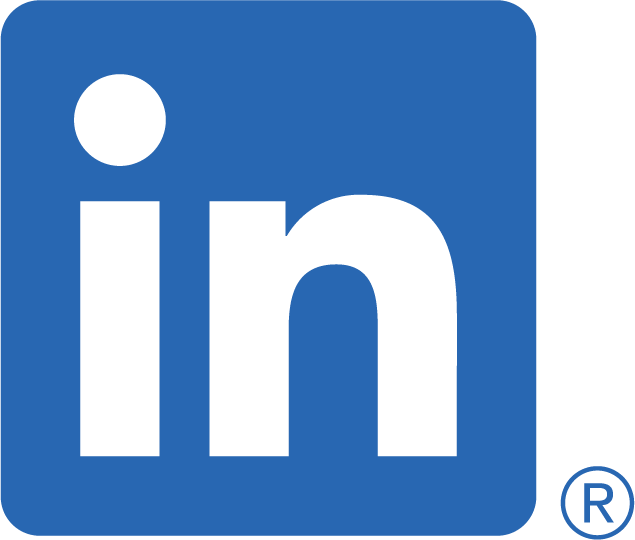Agile Project Manager Resume Example
Get started on your new resume right now with our practical resume writing guide. Want an interview worthy resume right away? Leet Resumes will write your resume for free.


How to write a great Agile Project Manager resume
As an Agile Project Manager, flexibility is one of your most important assets. You always have a direction for your projects, but you’ve also come to expect the unexpected, both in your life and at work. That’s one of your strong suits.
If features start taking longer to develop than anticipated or your engineers are struggling with integrations, a great Agile Project Manager knows how to adapt and improvise. You’re no stranger to using data for decision-making, you know how to walk the line between technical and business teams, and you have a reputation for getting it done.
From the initial research phase to deployment and iteration, you’re always looking for ways to improve your product. While doing more with less and maximizing efficiency seem straightforward enough, there’s no spreadsheet that can stand in for effective communication. A project manager needs to be able to clearly and concisely communicate what needs to be done.
Even if you’re an expert at communicating at work, you still might be struggling to write your resume. If you’re not sure where to start, don’t worry. Leet Resumes is here for you!
Since your resume is how you get your foot in the door, you want to keep it short, sweet, and to the point. Use an economy of words to show what you bring to the table. This means being clear about what you’re capable of, and being sure to show off how you brought value to your previous employers.
Ready to get started? It’s as easy as following our step-by-step walkthrough to create an awesome Agile Project Manager resume that will help you to win more job interviews.
Or there’s always the option of asking Leet Resumes to write it for you for free. We’ve helped thousands of professionals like you! Click here to learn more.
Tips and Advice for writing a project manager resume
You know how to get the most out of what’s at hand. Your job requires you to direct your teams for maximum efficiency by reducing rework and paring a product down to its most essential features to create a minimum viable product. Use this same logic to create your Agile Project Manager resume!
First off, you should never write in paragraphs on your resume. Recruiters and hiring managers aren’t going to slog through a dissertation. Especially in today’s competitive job market, you’re going to need two things to set yourself apart: being unique and to the point. Basically, your goal is to use the least words to make the best impression.
You also shouldn’t use any fancy fonts. Classics like Times New Roman and Arial will do. Along similar lines, you also want to avoid pictures, colors, text boxes, and additional columns.
Besides being superfluous for your human readers, these unconventional elements can also confuse the application tracking system (ATS) software that most employers use to sort resumes. If the ATS can’t parse your resume, the chance of you getting an interview goes way down.
Lastly, only include a link to your LinkedIn if you check it every day. You don’t want to miss an important message from a recruiter.
Can somebody write my resume for me?
If you’re starting to feel overwhelmed, then you’re not alone. We know that you’re more than capable of writing a great resume, but we also know that you have a lot on your plate.
Leet Resumes can take this burden off your shoulders by crafting a personalized Agile Project Manager resume for you at zero cost. Tips appreciated!
Formatting a great Agile Project Manager resume
Want to write to yourself? That’s a good idea, since nobody knows about your professional achievements and career goals like you do.
Just follow our resume outline and reference the resume example, and the writing process will go smoothly. Remember to prioritize quality over quantity.
Agile Project Managers love finding a formula that works, especially if it can save time, money, headache, or maybe even all three. Leet Resumes’ format is just that formula for writing a resume. It’s this simple:
- Name + Contact
- Professional Headline
- Professional Summary
- Work Experience
- Education
- Keywords
Follow this resume template and you can’t go wrong. Now let’s explore each section a bit more.
Name + Contact
Remember when Waterfall was the dominant methodology before Agile took over? It was all about starting at the beginning and working step-by-step towards a finished product. While we do recommend iterating on your resume, it’s also important to take that first step by writing your name at the top of your resume in a slightly larger font than the rest.
Under your name, write down your phone number and a professional email. You don’t need to include any social media profiles.
Professional Headline
When you report to stakeholders on your project status, you don’t start with all the granular details. You get them up to speed by giving them the gist of it. This section is the gist of your resume.
The goal of the professional headline is to convince them to keep reading. For instance, if they look down at your resume and see
“Product-Obsessed Agile Project Manager”
then they’re going to be intrigued!
Essentially, this section should be three to five words that hooks the reader by setting you apart from other managers who are applying to the same position.
Professional Summary
If the Headline was the gist, then the Professional Summary is the data to back it up. Of course, rather than raw data, you’re always going to present it in a digestible way, such as charts and graphs. Apply this same concision and clarity while following this structure:
- Three to four position titles that you would accept
- Agile Project Manager skills you possess
- Agile Project Manager achievements and accomplishments (optional)
- Awards and/or promotions (optional)
While every resume has to have the first two lines, as they explain what you want and what qualifications you have, the second half is a great opportunity for experienced professionals to make their mark. Since you’re applying for a management position, this can show how you worked your way up.
Work Experience
Now you can begin to bring in specific achievements that are unique to you. This is critical to getting an interview for a project management position. Since recruiters sort through resumes that only list a candidate’s employment history ad infinitum, they start to all look the same at a certain point.
Ask yourself: what does repeating daily duties really say about how well you can do your job?
A better approach is to focus on your agile project management accomplishments and success stories. Go beyond saying what you do on a day-to-day basis and highlight ways that you’ve added value or innovated in the past. Of course, always try to back up your claims with data.
Don’t forget numbers
How do you know if your project was successful or on the right track? You use metrics. Let the hiring manager know they're on the right track with your resume by proving what you’re capable of in a clear and quantifiable way: use more numbers!
If you’ve cut costs, say by how much. If you’ve hired and onboarded engineers, say how many. Write down how many projects you’ve overseen. This undeniable data clearly shows accomplishments in your past, so go through your resume when you’re done and then try to double the amount of numbers in it.
Lead with strong action verbs
Always begin a bullet point with an action verb, such as created, forecasted, or developed. Not only does it improve the brevity and force of your writing, but it also portrays you as an active and engaged personality—something that everyone is looking for in a new employee.
Always include dates
If you have a gap or two in your work history, don’t fall into the temptation of not citing specific dates on your resume. That will immediately throw up a red flag for the recruiter, and losing their trust is way more of a deal breaker than a common employment gap.
Education
Now list your educational background, including where you went to school, degrees, and GPAs. You should also include any certifications that you have for agile project management, such as PMI Agile Certifications like Disciplined Agile Scrum Master (DASM), PMI Agile Certified Practitioner (PMI-ACP), or Disciplined Agile Senior Scrum Master (DASSM).
The last thing to keep in mind is that you shouldn’t include any degrees that you didn’t finish unless you’re still working towards it.
Keywords
The final section of the Agile Project Manager resume template will list your hard skills and soft skills to leave a lasting impression. This is your last chance to show what you’re made of! Some potential keywords you can include are:
- Coordinating cross-functional teams
- Budgeting
- Presentation and communication
- Compliance and Security
- Scrum
You should also cite specific technologies that you use in your work. These can range from the most technical—coding languages, CAD, etc.--to more business-focused applications like Kanban boards, project management software, or MS Office suite.
That’s all there is to it! Now the choice is yours to either write an awesome resume or get Leet Resumes to write a fully optimized resume just for you. It’s completely free, and all we ask is that you consider leaving a tip at the end for a job well done.










